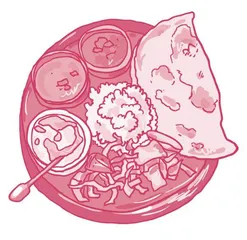A Chinese Food and Culture Tour Through London伦敦的中华美食文化之旅
作者: 梅甘·伊夫斯 黄媛/译

I miss China. It’s been three long years since I was last there and the itch for street noodles, speedy trains and the wafting scent of temple incense has become overwhelming.
我想念中国。距我上次的中国之行已有三年之久。对炒粉、高铁和寺庙香火味的渴望已变得难以抑制。
Luckily I live in London, a city with historical ties to the Middle Kingdom. With lockdowns lifted here, I set out to get my China fix1 in the British capital.
所幸我生活的伦敦与中国颇有历史渊源。这里的疫情封控解除,我在英国首都开启了中华美食之旅。
My first stop is Bell Lane, in East London, where it is possible to do a short noodle crawl2. Noodle and Beer provides a tongue-numbing Chongqing xiao mian but before I move on to a dinner of Guilin-style mifen at Chew Fun a few doors down, I am distracted in Spitalfields Market by pearl milk tea and someone serving savoury jianbing pancakes from a food stall. I return home and fall into an early food coma.
我的第一站是伦敦东区的贝尔街,在这儿可以来一次短暂的面条之旅。“彼儿小面”家的重庆小面让人嘴辣舌头麻。到距离不远的“吃范儿”享用桂林米粉之前,我还尝了尝斯皮塔尔菲尔茨市场的珍珠奶茶和小吃摊上的美味煎饼。吃饱了回家就犯困,早早睡去。
Another day, another lunch3, this time at Xi Home Dumplings, near Trafalgar Square, where I fill up on jiaozi and an accurately rendered roujiamo pork sandwich. Years ago, a friend pointed out that roujiamo sounds like “Roger Moore4” and now I can’t order one without also craving a martini.
又是新的一天,又是一顿午餐,这次是在特拉法尔加广场附近的“喜家饺子店”。我点了不少饺子,还吃了一个口味地道的肉夹馍。几年前,一位朋友提到,肉夹馍听起来像“罗杰·摩尔”,以至于现在我只要点了肉夹馍,就还想来杯马提尼酒。
That evening, I sit down with a fellow Sinophile at The Alma, near the Angel tube station, with London-brewed One Mile End IPAs5 and giant bowls of Yunnanese “crossing-the-bridge” rice noodles (guoqiao mixian). The warming bone broth is speckled with bright, red goji berries and fresh chrysanthemum petals. Heaven in Angel!
当晚,我和一位也喜欢中国的朋友在天使地铁站附近的“阿尔玛”餐厅坐下,喝着伦敦酿造的One Mile End牌印度淡色艾尔啤酒,两人都吃着大碗的云南过桥米线。热乎的骨头汤点缀着红红的枸杞和新鲜的菊瓣。简直是天使的天堂!
For my next culinary trip, I round up a friend who has just returned from a few years’ living in China. We visit Silk Road, in Camberwell, which purports to serve Xinjiang-style food. The spicy lamb skewers6 take me straight back to a street table in Lanzhou, drinking Huanghe beer to a soundtrack of passing mopeds7.
下一站的美食之旅,我找来一位在中国生活了几年刚回国的朋友。我们来到位于坎贝尔韦尔的“丝路”饭馆,那里说是供应新疆风味的美食。麻辣羊肉串把我直接带回兰州街头的一张餐桌,伴着驶过的机动自行车上飘来的音乐,畅饮“黄河”啤酒。
I am invited for an evening of finery at China Tang, the upmarket restaurant and bar inside the Dorchester Hotel. Dressed in our best, my companion and I descend into the art-deco lounge styled like a 1930s Shanghai speakeasy8, where we are handed small bottles of Tang Tea Punch9, a potent blend of gin, osmanthus tea, hibiscus syrup and jasmine bitters produced in-house. One sip and I can’t help recalling another night, some years ago in Shanghai, sipping a gin cocktail in the lush bar at the Ruijin Hotel.
我受邀在多切斯特酒店内的高档餐厅兼酒吧“唐人馆”度过一个精致的夜晚。我和同伴穿着最上档次的衣服,走进了具有装饰艺术风格的高级酒吧间,这儿的陈设就像20世纪30年代的上海“黑酒吧”。我们一人来了一小杯这家店特制的唐茶潘趣酒,这是一种由金酒、桂花茶、木槿糖浆和茉莉花苦啤酒调制而成的浓酒。抿一小口,便不由得回想起几年前上海的一个夜晚,在瑞金酒店的豪华酒吧里,品尝着以金酒为基酒的鸡尾酒。
The punch having done its work, we sit at a white-linen-covered table in the formal dining room and order basket upon basket of delicate dim sum, washed down with a top-shelf 2013 Ao Yun red wine from Yunnan, while spying on someone who might be a famous rapper at a nearby table.
酒足微醺,我们移步至正式餐厅里一张铺着白色亚麻桌布的桌子旁,点了一篮又一篮的精致点心,伴着产自云南的2013年份顶级敖云红酒,一边偷瞟附近桌可能是位著名说唱歌手的食客。
By now, it is time to explore the heart of Chinese culture in London: Chinatown10. I join a monthly walking tour led by a volunteer from China Exchange, a non-profit dedicated to fostering understanding and spreading appreciation of Chinese culture. She gives us the history of Chinatown, from its origins as a military ground owned by Charles Gerrard, Earl of Macclesfield (this explains about 25 per cent of the district’s street names), to becoming the home of the aristocracy in the 1700s, then declining into tenements by the 20th century, when Chinese immigrants and workers moved in from the docks at Limehouse11.
至此,是时候来探索伦敦中国文化的核心了——中国城。我参加了由中国交流中心一位志愿者组织的月度徒步旅行。中国交流中心是非营利组织,致力于促进理解和传播中国文化。志愿者向我们介绍了中国城的历史。这里最初是麦克尔斯菲尔德伯爵查尔斯·爵禄拥有的军事用地(中国城约1/4的街道名称都与他的名字相关),18世纪成为贵族的居所,20世纪中国移民和工人从莱姆豪斯的码头搬过来后,逐渐成为廉租公寓。
Several dim sum restaurants were opened by Hongkongers in Chinatown in the 1960s, along with London’s first Asian supermarket—Loon Fung, which brought bok choy to Britain and now operates stores in five locations in the capital. By 1985, Chinatown was officially recognised on maps. The lamp posts were painted red and gold, fu dog12 statues were put up on Gerrard Street and Chinese translations were added to the street signs.
20世纪60年代,香港人在中国城开了几家点心店,以及伦敦第一家亚洲超市——“龙凤行”,这家超市把白菜带到了英国,如今在伦敦有五个门店。到1985年,中国城终获官方认可,得以标示在地图上。灯柱刷上了红漆和金漆,爵禄街上摆上了石狮子,路牌上增加了中文翻译。
The tour finishes with a meal at Cantonese banquet restaurant Golden Phoenix.
游览结束后,我们在粤式酒家“金凤凰”用餐。
The following evening, I meet my Sinophile friend (somehow still not tired of being my sidekick) back in China- town, in front of the jade door of a Gerrard Street speakeasy. After a large bouncer13 checks my name against a list, we are let in from the bright spring evening to a dark stairwell.
第二天傍晚,我和那位喜欢中国的朋友(不知何故,依然开开心心地跟着我)约在中国城爵禄街一家“黑酒吧”的绿门前见面。一名大个子保安对照名单核对了我的名字后,把我们从灯火辉煌的春夜让进了昏暗的楼梯间。